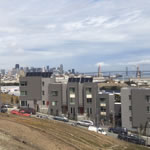Imagine an old, dilapidated housing complex that is nearly uninhabitable and heavily isolated from the surrounding community. This is an apt portrait of Hunters View in the Bayview Hunters Point area of San Francisco. A complete redesign, however, is bringing the complex back to life.
Originally built in 1956, the 267-unit development has been restructured for 800 units in a new master plan developed by Mithun Solomon. “Their design is community-friendly, environmentally sustainable, and easily accessible via new and reconfigured city streets,” explains Paulett Taggart, principal of Paulett Taggart Architects (PTA). The new Hunters View, which includes parks, a community center, walking paths, and bike racks, received certification under the USGBC’s new pilot program for LEED for Neighborhood Development (LEED-ND).
The plan consists of three phases of mixed affordable housing, as well as market-rate housing. PTA was hired to design 53 units in blocks five and six as part of phase one, which was occupied in April 2013, and 107 units in phase two.
“The redesign turns two-story units in blocks five and six into three- and four-story stacked multilevel units around a courtyard with more density on all streets,” Taggart says, adding that the steep-sloping terrain drove the whole design. “Someone can enter many of the units from two sides because the elevation changes a full story between one side of the unit and the other, but due to the grade change, no one has to walk up more than one flight of stairs.”
The one- to five-bedroom units, which range from 750 square feet to 1,730 square feet, have large windows with low-E glass for ample daylight and cross-ventilation. “Photovoltaic panels on the white roof are expected to significantly offset the exterior and common-area electricity while the solar thermal systems will offset the domestic hot-water demands,” says Roselie Enriquez, an associate at PTA.
Interior materials such as carpet, resilient flooring, and cabinetry were chosen for durability and indoor air quality by selecting options with little to no off-gassing. Cementitious panels and exterior plaster have durable exterior finishes. The steel and concrete both included some recycled content, and the landscaping is entirely native plantings. Recycling was a big part of the demolition. Eighty-nine percent of all construction waste and 100 percent of concrete and asphalt were diverted from landfills.
Building code requires designated units to have wheelchair access, but PTA went beyond the code. “Where we were able, we added a bedroom on that level and made sure the bathrooms were full baths,” Taggart says. “The intent was to provide a place where a family member with special needs, such as an elderly parent, would be fully accommodated.”
But another code was restrictive because it prevented the site from increasing its amount of storm water. “That was challenging because we were increasing the number of units,” Taggart says. “The natural rock material is serpentine, which isn’t consistently permeable, so the team designed storm-water storage tanks under the new Promontory Park.” In phase two, for blocks seven and eleven, they plan to provide more areas for the storm water to permeate the ground and strategically locate drywells at low elevation points.
Taggart says that the row houses will have their own yards and the larger common open space will be accessed from the apartment buildings, but Taggart had to be open to working with the land. At block seven, PTA is proposing to put in a planted swale in the middle of the block to work with the site’s steeper slopes.
As tenants move in, the feedback has been positive. “Residents seem very happy, and that’s rewarding,” Taggart says. “They can see the difference in their neighborhood.”
A Message from Sun Light & Power
Since 1976, Sun Light & Power has offered sustainable solar solutions for a variety of forward-thinking projects. We work collaboratively with leading architects, developers, and general contractors to design and build smart, cost-effective energy packages that focus on reducing operating expenses as well as providing maximum environmental benefits.

